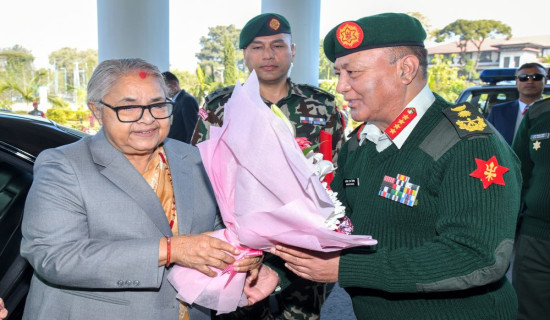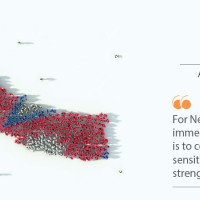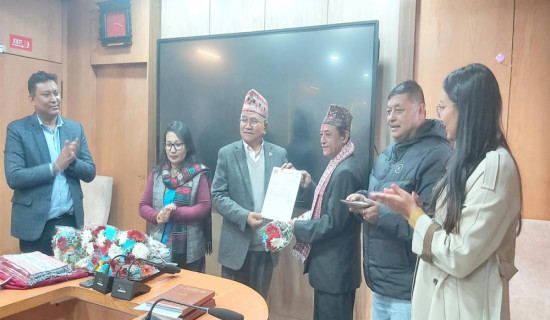- Friday, 28 November 2025
A Game Changer For Economy
Laxman Kafle
Our economy is in a woeful state with the rise in trade imbalances and the depletion of foreign exchange reserves. However, amid such an unfavorable period, the export sector has provided a glimmer of hope for our sagging economy.
Nepali industries have started exporting three potential products - electricity, cement, and steel - offering much-needed succor to our beleaguered economy.
Though many among us are not buoyant over the export of steel products owing to many unfavorable reasons, the export of electricity and cement could be a real game changer for the Nepali economy.
Nepal has begun collecting revenue through electricity selling to the Indian market. Initially, 39 MW of electricity was sold to the Indian Energy Exchange (IEX) market.
Since June 10, 364 MW is being sold daily at a competitive rate in the Indian market. The Nepal Electricity Authority (NEA) has received approval from the Central Electricity Authority under the Ministry of Power of India to sell 364 MW of electricity generated from six Nepali hydropower projects in the IEX market.
Currently, Nepal is earning foreign currency equivalent to around Rs. 2.5 billion per month by selling its power. However, the NEA can export electricity only in the rainy season or when the national production can not get consumed here.
Such exports are likely to increase every year. In the last fiscal year alone, electricity generation increased by about 700 megawatts, and generation is projected to be increased in this quantity in the current fiscal year.
On the one hand, it has helped to address growing consumption with sustainable and reliable electricity supply within Nepal; on the other hand, it has opened new avenues for exporting other potential products.
Since electricity production and export are based on Nepal's domestic natural resources, the country can reap benefits from these sectors. India and Bangladesh are the most potential markets for the export of electricity generated in Nepal. Our current installed capacity for the hydropower project is 2,190 MW at present. 
Electricity Contribution
"Looking at the amount of electricity exported in the month and the sale price obtained from it, the electricity trade with India has moved forward effectively. This will help reduce some of Nepal's trade deficit with India and also contribute to the country's balance of payments in surplus," says Kul Man Ghising, managing director for Nepal Electricity Authority.
Electricity worth Rs. 4 billion was exported in the two months of last fiscal year and NEA is likely to export power worth around Rs. 15 billion to Rs. 20 billion in the coming fiscal year, including the current fiscal year.
Electricity exports will go above Rs. 100 billion in four to five years. The income from power sales can be utilized to add more hydel projects and to build reservoir-type power projects in many snow-fed rivers of Nepal.
The sale of electricity in the Indian market is a milestone for electricity trade between the two countries. With the beginning of export, the Joint Vision on Energy Cooperation issued jointly by the prime ministers of Nepal and India has entered a new phase of implementation. During the visit of Prime Minister Sher Bahadur Deuba to India last April, a joint vision statement on power sector cooperation between Nepal and India was issued.
"We are exporting all the surplus electricity after domestic consumption. The situation of going to waste of the produced electricity in the country has come to an end for the time being. We are in continuous discussions with the Indian side for approval for further export of electricity in the coming days," says Ghising.
According to him, our priority is the consumption of electricity within the country, and for that, the state needs to increase investment in the infrastructure of transmission and distribution systems.
Apart from India, Nepal is also taking initiatives to export electricity to Bangladesh. For the development of Nepal's energy sector, it is necessary to export electricity to Bangladesh by constructing high-capacity cross-border transmission lines at the earliest.
Currently, only the Dhalkebar-Muzaffarpur cross-border transmission line (400 kV) connecting Nepal and India is in operation. With the recent implementation of the MCC project, the regional potential market for power selling to Bangladesh will expand further.
Other transmission lines are also in operation, but the capacity of those transmission lines are only 220 kV, 132 kV, 66 kV, and 33 kV. The government is in the process of constructing the Butwal Gorakhpur cross-border transmission line. Now, the development of transmission infrastructure should be given top priority.
Similarly, increasing the production of electricity can reduce the import of petroleum products, including liquefied petroleum products. The government is encouraging people to use electric vehicles and electric stoves to reduce the import of fuel and LPG.
To promote electric vehicles, the Nepal Electricity Authority has taken the initiative for the construction of charging stations itself and also encouraged the private sector to construct them by providing electricity at a cheaper rate. If we can replace LPG with an electricity medium, the trade deficit can be reduced by reducing the import of petroleum products.
The share of petroleum products in the total import trade stands at around 17 percent. The country has imported petroleum products, including LPG worth Rs. 320 billion in the last fiscal year alone.
Cement Export
For the first time, Nepal has started exporting cement to India. The official process began on July 8 with Palpa Cement Industries Limited exporting its Tansen brand to India. The environment of exporting Nepali cement to India was created and materialized due to the programs set in the annual budget for 2022/23.
The government has introduced a subsidy of 8 percent in cash to companies exporting cement using Nepali raw materials.
Similarly, Shree Steel has too started exporting steel from Nepal. The possibility of long-term export of steel is low and may have to face the fate like the export of palm oil. Because all its raw materials have to be imported till now, whereas laborers and electricity are being used here.
But the possibility of cement export is more reliable. More than five dozen cement industries have opened now. Foreigners have also joined in this investment.
Especially, after the 2015 earthquake, there has been a significant increase in investment in the cement and iron rod industries. Due to this, the production capacity of industries is more than the domestic demand. Exports of cement and rod are taking place even when the industry has not been able to operate it at full capacity.
According to Nepal Steel Rolling Mills Association, there are more than 30 steel industries in Nepal. At present, Nepal has an annual production of about 1.6 million tonnes of steel and the industries can be operated to produce 80 to 90 percent of the installed capacity.
Dhruba Raj Thapa, president of the Cement Manufacturers Association of Nepal says that the ray of hope in the field of cement sector has started following the beginning of the export of cement to India.
"Cement is an industry based entirely on domestic raw materials. The export of cement would support the country in reducing the rampant trade deficit as it can export with huge value addition," he says.
Private sector investment in the cement sector has excited many with the announcement to provide cash incentives for exports. However, since the transportation cost of cement is high, the possibility of exporting cement to other nations is negligible, says Thapa.
Around 65 cement industries, including small and large, have an investment of Rs. 300 billion and can produce more than 25 million tonnes yearly. At present, domestic consumption stands at around 10 million tonnes annually and the remaining 15 million tonnes can be exported.
Beginning the export, Shree Steels exported 35 tonnes of iron rods in a truck to Kunserawa in Maharajgunj, India through the Belhia border in the first batch.
The steel industry has claimed that Nepali industries can export 1.5 million tonnes of iron and steel per year.
Kiran Sakha, chairman of Sakha Group, says that although the export of steel to India is positive, it is important to continue the export by taking export incentives based on value addition. "Even though the government is said to provide 8 percent cash incentives, this product will be able to prove the value addition to be eligible to get cash incentives," he says.
It is challenging to give continuity to the export of steel from Nepal with significant value addition to imported raw materials.
Trade Deficit Exceeds Annual Budget
Nepal's trade deficit swelled to a record of Rs. 1,720.41 billion in the last fiscal year, driven by significant imports of petroleum products and a low volume of exports. The country's trade deficit is higher than the annual budget presented by the government in the last fiscal year. In the last fiscal year, the total budget amounted to Rs. 1,564 billion.
According to the annual trade statistics published by the Department of Customs, the country’s trade deficit has increased by 23 percent in the last fiscal year 2021/22. In the previous fiscal year 2020/21, Nepal had faced a trade deficit of Rs. 1,398.71 billion.
Import trade increased by 24.72 percent to Rs. 1,920.44 billion during the review period, resulting in a high trade deficit. In the fiscal year 2020/21, the country imported goods worth Rs. 1,539.83 billion.
Spikes in petroleum prices due to the Russia and Ukraine war increased import bills causing pressure on foreign currency reserves and balance of payment.
According to the statistics, total foreign trade has also increased. The country's foreign trade reached Rs. 2,120.47 billion during the last fiscal year which is 26.15 percent more than the previous fiscal year.
Export Sets Record
In the meantime, Nepal’s export trade has set a historic record in the last fiscal year. The country exported goods worth Rs. 200.03 billion (41.47 percent growth) during that period, a record-high export for Nepal so far. Exports had crossed one hundred billion marks for the first time in the fiscal year 2020/21, reaching Rs. 141 billion.
Even though exports went up significantly, the ratio of export to imports is still 1:9.60.
The share of export in the total foreign trade is only 9.43 percent, while that of imports is at a whopping 90.57 percent.
The statistics showed that the growth of export in soybean and palm oil significantly contributed to the achievement in export growth in the last fiscal year. Soybean, palm, and sunflower oil shares in the export trade stood at around 47 percent during the review period. The country exported soybean oil worth Rs. 48.12 billion, palm oil worth Rs. 41.04 billion, and sunflower worth Rs. 4.5 billion in the last fiscal year.
The government should continue supporting domestic industries to increase exports and reduce the trade deficit. "It is a must to continue government support to increase investment in the industries along with the export promotion," Thapa said.
Recently, while addressing a function, the Prime Minister assured the businessmen that the government is committed to legal, political, and institutional reforms to increase investment and production in the country. The promotion of industries based on local raw materials instead of imported raw materials to make a self-reliant economy and reduce the trade deficit.
Thapa claims that the industry can export more than Rs. 150 billion worth of cement annually if the government supports it and other environments remain favorable for export. These industries have begun producing cement as per Indian standards, which is a must before exporting them to the Indian market.
Improving Supply
Supply-side constraints – low production, high cost, and lack of investment in manufacturing industries – are the major bottlenecks to increasing export, so it is needed to improve the production of exportable products in mass quantities.
There is no problem with the market for Nepali products, but Nepal cannot increase exportable items having quality and competitive prices, which has created a bottleneck for export so far.
Considering the supply side constraints for export promotion, the government and the private sector should focus on the production of comparative advantageous goods in large quantities to boost trade and narrow the trade deficit.
Every step of such an integrated approach, including the availability of raw materials, transportation, storage, processing, technology, capital, human resources, industrial environment, tax policy, financing, diplomacy, promotional activities and trade-related infrastructure needs to be enhanced to boost export trade.
It is good to increase exports by adding value to imported goods but the government should hold dialogue with the concerned countries for the sustainability of emerging exportable products. There is no way to minimize the trade deficit due to a lack of mass production and cash incentives on export at par with our competitive countries – India, China, and Bangladesh.
(A journalist at TRN, Kafle writes on the economy, trade, and business)




-square-thumb.jpg)




-original-thumb.jpg)

-original-thumb.jpg)


-original-thumb.jpg)
